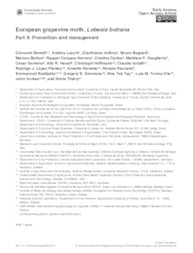European grapevine moth, Lobesia botrana. Part II: Prevention and management.
European grapevine moth, Lobesia botrana. Part II: Prevention and management.
Author(s): BENELLI, G.; LUCCHI, A.; ANFORA, G.; BAGNOLI, B.; BOTTON, M.; CAMPOS-HERRERA, R.; CARLOS, C.; DAUGHERTY, M. P.; GEMENO, C.; HARARI, A. R.; HOFFMANN, C.; IORIATTI, C.; PLANTEY, R. J. L.; REINEKE, A.; RICCIARDI, R.; RODITAKIS, E.; SIMMONS, G. S.; TAY, W. T.; TORRES-VILA, L. M.; VONTAS, J.; THIÉRY, D.
Summary: Lobesia botrana (Denis & Schiffermüller) (Lepidoptera: Tortricidae), commonly known as the European grapevine moth (EGVM), is a primary pest of vineyards. This article provides an updated review of its monitoring, modelling, and management tools. EGVM management strategies analysed here include insecticide-based control, insecticide resistance, side-effects (particularly those caused by the exposure to sublethal doses of pesticides), cultural control, sterile insect technique, pheromone-mediated control strategies (with special reference to pheromone-based mating disruption), biological control, and area-wide control programs. Lastly, we outline significant challenges for future EGVM research and sustainable control implementation.
Publication year: 2023
Types of publication: Journal article
Unit: Embrapa Grape & Wine
Observation
Some of Embrapa's publications are published as ePub files. To read them, use or download one of the following free software options to your computer or mobile device. Android: Google Play Books; IOS: iBooks; Windows and Linux: Calibre.
Access other publications
Access the Agricultural Research Database (BDPA) to consult Embrapa's full library collection and records.
Visit Embrapa Bookstore to purchase books and other publications sold by Embrapa.

